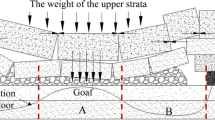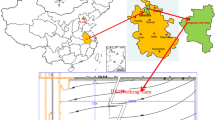Abstract
The discussion of stress evolution law and failure characteristics of rock mass in mining floor above confined water is the key to control the floor water inrush in deep mining. Based on analyzing the strike support pressure of working face, the mechanical model of coal floor above the confined water was established. Then, vertical, horizontal and shear stress distribution maps and the failure range morphological map of mining floor were calculated based on data processing software Origin. Then, with the similar simulation test bed for water inrush from coal seam floor, the fluid solid coupling simulation material was selected, and the stress evolution law and failure characteristics of coal seam mining floor were improved. The results showed that the vertical stress contour is a “semi-elliptical” shape distribution and the greater the floor depth, the smaller the affected degree, but the influenced range increased. The higher shear stress zone occurred in the vicinity of working face coal wall. The failure range morphological map of mining floor was approximately a spoon shape and maximum failure depth was 14.0 m based on the mechanical theory. The maximum failure depth of the floor was 13.4 m based on the similar simulation experiment. So, the experimental results are in agreement with the theoretical results. The results in this paper can provide theory basis for safety mining above confined water.
Similar content being viewed by others
References
Boussinesq, J. V. (1885). Applications of the potentials to study of the equilibrium and of the move for the elastic solides, GaUthiers Villars, Paris.
Feng, M. M., Mao, X. B., Bai, H. B., and Wang P. (2009). “Experimental research on fracture evolution law of water-resisting strata in coal seam floor above aquifer.” Chin J Rock Mech Eng, Vol. 28, No. 2, pp. 336–341, DOI: 10.3321/j.issn:1000-6915.2009.02.017.
Gui, H. R. and Lin, M. L. (2016). “Types of water hazards in China coalmines and regional characteristics.” Nat Hazards, Vol. 84, pp. 1501–1512, DOI: 10.1007/s11069-016-2488-5.
Hu, Y. Q., Yan, G. C., and Shi, X. W. (2008). “Study on physics and numerical simulation of water inrush prediction theory for coal mining above confined aquifer.” Chin J Rock Mech Eng, Vol. 27, No. 1, pp. 9–15, DOI: 10.3321/j.issn:1000-6915.2008.01.002.
Jiang, Y. D., Lv, Y. K., Zhao, Y. X., and Zhang, Y. (2011). “Similar simulation test for breakage law of working face floor in coal mining above aquifer.” Chin J Rock Mech Eng., Vol. 30, No. 8, pp. 1571–1579.
Jiang, Z. H. (2011).”Numerical analysis of the destruction of waterresisting strata in a coal seam floorin mining above aquifers.” Mining Science and Technology(China), Vol. 21, pp. 537–541, DOI: 10.1016/j.mstc.2011.06.013.
Li, S. C., Feng, X. D., and Li, S. C. (2010). “Research and development of a new similar material for solid-fluid coupling and its application.” Chin J Rock Mech Eng., Vol. 29, No. 2, pp. 281–288.
Li, S. C., Zhou, Y., and Li, L. P. (2012). “Development and application of a new similar material for underground engineering fluid-solid coupling model test.” Chin J Rock Mech Eng., Vol. 31, No. 6, pp. 1128–1137, DOI: 10.3969/j.issn.1000-6915.2012.06.006.
Liu, X., Sheng, Q., and Chen, J. (2015). “Seismic shaking table test for large-scale underground cavern group (I): Proportioning test on similar materials of surrounding rock.” Rock and Soil Mechanics, Vol. 36, No. 1, pp. 83–88, DOI: 10.16285/j.rsm.2015.01.011.
Lu, Y. L. and Wang, L. G. (2015). “Numerical simulation of mininginduced fracture evolution and water flow in coal seam floor above a confined aquifer.” Computers and Geotechnics, Vol. 67, pp. 157–171.
Luo, L. P. and Peng, S. P. (2005). “Mechanism study on water-inrush hazard of floor strata in mining on confined aquifer.” J China Coal Soc, Vol. 30, No. 4, pp. 439–462, DOI: 10.3321/j.issn:0253-9993.2005.04.012.
Meng, X. R., Xu, C. H., and Gao, Z. N. (2010). “Stress distribution and damage mechanism of mining floor.” J. China Coal Soc, Vol. 35, No. 11, pp. 1832–1836.
Pang, Y. H., Wang, G. F., and Ding, Z. W. (2014). “Mechanical model of water inrush from coal seam floor based on triaxial seepage experiments.” Int. J. Coal Sci. Technol., Vol. 1, No. 4, pp. 428–433, DOI: 10.1007/s40789-014-0049-7.
Si, R. J., Wang, C. Q., and Tan, Y. L. (2007). “Numerical simulation of abutment pressure distribution laws of working face.” Rock and Soil Mechanics, Vol.28, No. 2, pp. 351–354, DOI: 10.3969/j.issn.1000-7598.2007.02.028.
Sun, J., Wang, L. G., and Tang, F. R. (2011). “Micro-seismic monitoring failure characteristics of inclined coal seam floor.” Rock and Soil Mechanics, Vol. 32, No. 5, pp. 1589–1595, DOI: 10.3969/j.issn. 1000-7598.2011.05.046.
Sun, W. B. (2013). Experimental study on the formation and evolution of water inrush channel in deep mining, PhD Dissertation, Shandong University of Science and Technology.
Sun, W. B., Zhang, S. C., and Li, Y. Y. (2015). “Development application of solid-fluid coupling similar material for floor strata and simulation test of water-inrush in deep mining.” Chin J. Rock Mech Eng., Vol. 31, No. S1, pp. 2665–2670.
Wang, L. G., Han, M., and Wang, Z. S. (2013). “Stress distribution and damage law of mining floor.” Journal of Mining & Safety Engineering, Vol. 30, No. 3, pp. 317–322.
Wang, Z. Y. and Liu, H. Q. (1992). “Coal mining on confined water.” China Coal Industry Publishing House, Beijing, pp. 20–21.
Wu, Q. (2014). “Progress, problems and prospects of prevention and control of mine water and reutilization in China.” J China Coal Soc, Vol. 39, No. 5, pp. 795–805, DOI: 10.13225/j.cnki.jccs.2014.0478.
Wu, Q., Liu, Y. Z., and Liu, D. H. (2011). “Prediction of floor water inrush: The application of GIS-Based AHP vulnerable index method to Donghuantuo Coal Mine, China.” Rock Mech Rock Eng., Vol. 44, pp. 591–600, DOI: 10.1007/s00603-011-0146-5.
Wu, Q., Zhou, W., Wang, J., and Xie, S. (2009b). “Prediction of groundwater inrush into coal mines from aquifers underlying the coal seams in China: application of vulnerability index method to Zhangcun Coal Mine, China.” Environ Geol, Vol. 57, No. 5, pp. 1187–1195, DOI: 10.1007/s00254-008-1415-9.
Xu, Z. L. (2001). “Elastic mechanics.” Higher Education Press, Beijing, pp. 178–200.
Yin, S. X., Zhang, J. C., and Liu, D. M. (2015). “A study of mine water inrushes by measurements of in situ stress and rock failures.” Nat Hazards, Vol. 79, pp. 1961–1979, DOI: 10.1007/s11069-015-1941-1.
Zhang, J. C. (2005) “Investigations of water inrushes from aquifers under coal seams.” Int. J. Rock Mech Min, Vol. 42, No. 3, pp. 350–360, DOI: 10.1016/j.ijrmms.2004.11.010.
Zhang, J. C., Zhang, Y. Z., and Liu, T. Q. (1997). “Seepage of rock mass and water inrush from coal seam floor.” Geological Publishing House, Beijing, pp.10–15.
Zhang, L. M., Wang, Z. Q., and Sun, H. (2009). “Failure characteristics and constitutive model of rock under unloading condition.” J. China Coal Soc, Vol. 34, No. 12, pp. 1626–1630, DOI: 10.3321/j.issn:0253-9993.2009.12.008.
Zheng, Y. R. and Kong, L. (2010). “Plastic mechanics of rock and soil.” China Building Industry Press, Beijing, pp. 36–52.
Zhu, S. Y, Jiang, Z. Q., Zhou, K. J., Peng, G. Q., and Yang, C. W. (2014). “The characteristics of deformation and failure of coal seam floor due to mining in Xinmi coal field in China.” Bull Eng Geol Environ, Vol. 24, pp. 1151–1163, DOI: 10.1007/s10064-014-0612-x.
Zhu, S. Y., Jiang, Z. Q., and Hou, H. L. (2008). “Analytic method for strain on extracting seam floor at relatively fixed position and its application.” Mining Safety & Environment Protection, Vol. 35, No. 1, pp. 18–20.
Zhu, S. Y., Jiang, Z. Q., and Yao, P. (2007). “Application of analytic method in calculating floor stress of a working face.” Journal of Mining & Safety Engineering, Vol. 24, No. 2, pp. 191–194, DOI: 10.3969/j.issn.1673-3363.2007.02.015.
Author information
Authors and Affiliations
Corresponding author
Rights and permissions
About this article
Cite this article
Liu, S., Liu, W. & Shen, J. Stress evolution law and failure characteristics of mining floor rock mass above confined water. KSCE J Civ Eng 21, 2665–2672 (2017). https://doi.org/10.1007/s12205-017-1578-6
Received:
Accepted:
Published:
Issue Date:
DOI: https://doi.org/10.1007/s12205-017-1578-6




